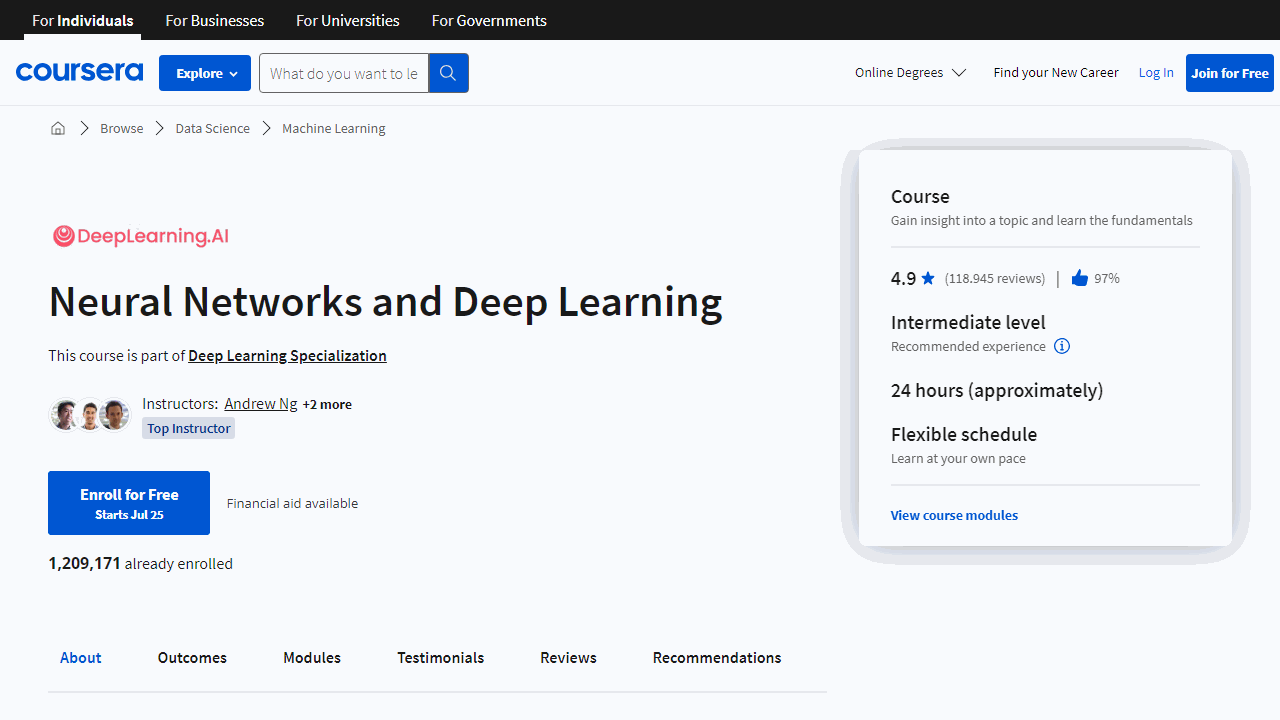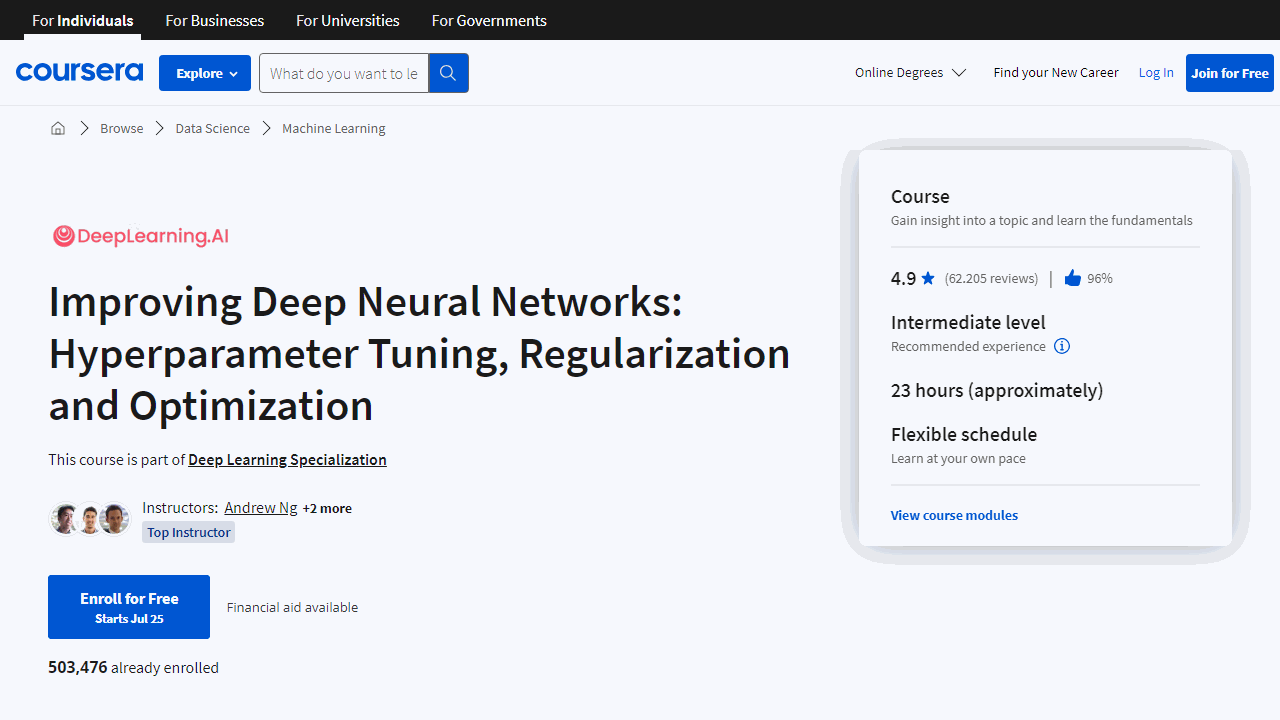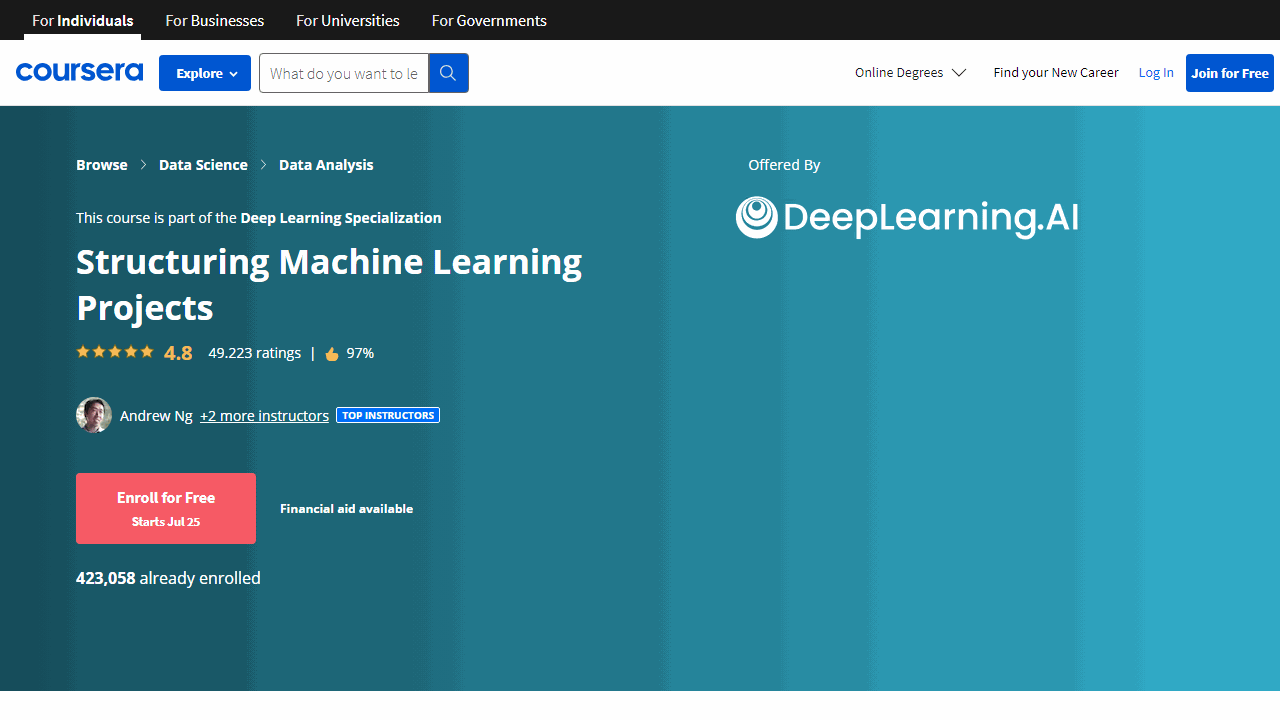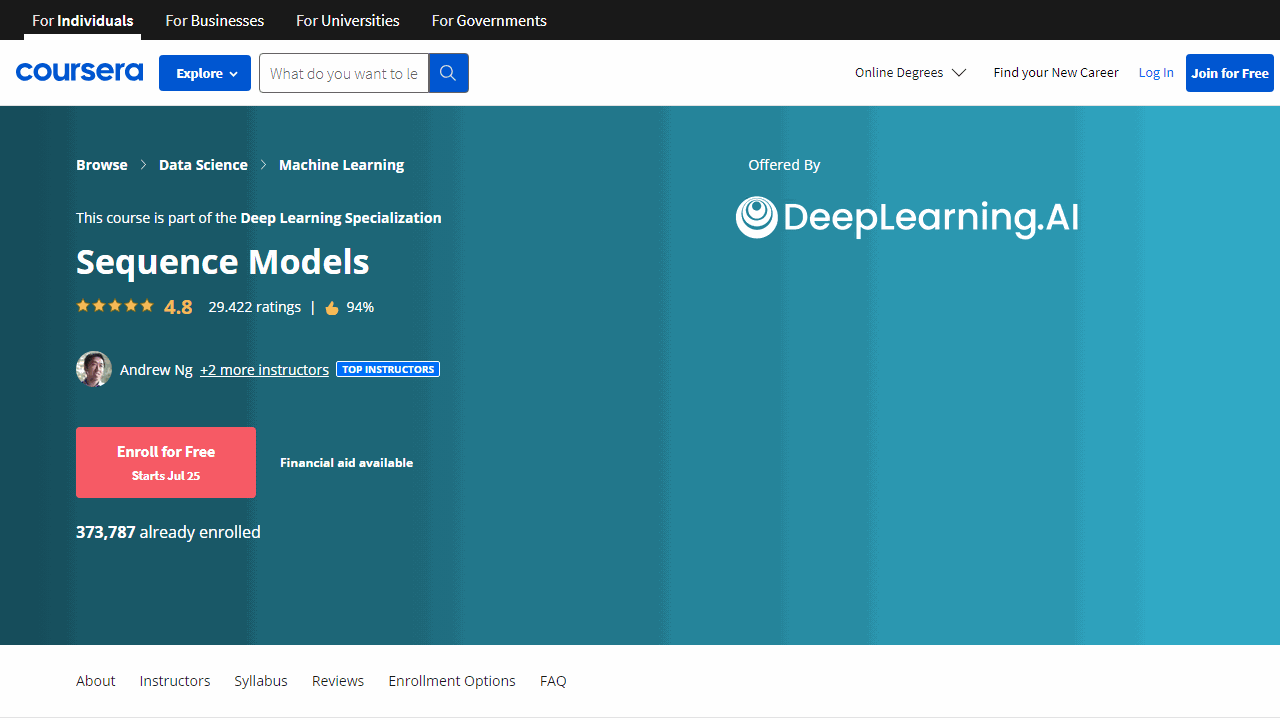- Provider: DeepLearning.AI, Stanford University
- Teacher: Andrew Ng, Younes Bensouda Mourri, Kian Katanforoosh
- Price: $49/month with a 7-day free trial
- Duration: Approx. 5 months if you study 7 hours per week
- Pre-requisites: intermediate Python skills, basic Linear Algebra and machine learning knowledge
- Level: Intermediate
- Certificate: Yes
Are you interested in deepening your knowledge of machine learning and neural networks, but unsure where to start?
Maybe you’ve tried to learn on your own with the thousands of data science resources out there, but found the material too complex or poorly structured.
Or perhaps you’ve taken a course, but found it lacked practical assignments to reinforce the concepts.
Well, you’re not alone. Many people face these challenges when trying to learn about these complex topics.
The good news is, there’s a solution.
Coursera offers a 5-course Deep Learning specialization, taught by renowned instructor Andrew Ng, that are designed to take you from intermediate to advanced knowledge in machine learning and neural networks.
If you took the Machine Learning Specialization, you’ll be familiar with the instructor’s teaching style and the course structure.
These courses offer a comprehensive overview of the topics, starting from the basics and gradually progressing to more advanced concepts.
They are well-structured and thoroughly explained, making them an excellent resource for those seeking a solid understanding of these fields.
The courses also include practical assignments to reinforce the concepts and provide real-life examples of how they can be applied.
So, let’s dive in and explore these courses in more detail.
Neural Networks and Deep Learning

- Rating: 4.9/5 with 118.931 ratings
- Duration: Approx. 24 hours
My impression of the course is generally positive.
Indeed, the course offers a comprehensive overview of neural networks, starting from the very basics and gradually progressing to more advanced topics.
Instructor Andrew Ng does an excellent job of explaining complex ideas in a way that’s easy for beginners to grasp.
The material is well-structured and thoroughly explained, making it an excellent resource for those seeking a solid understanding of neural networks and deep learning.
However, there are a few areas where the course could improve.
The assignments, although helpful in reinforcing the learned concepts, lack a certain level of challenge.
The overabundance of pre-written code doesn’t push students to think critically or encourage deeper engagement with the material.
This, coupled with the focus on matching expected output, may leave students with a superficial understanding of the concepts.
Despite these drawbacks, the course is a great starting point for anyone interested in neural networks.
The use of (Python) Jupyter notebooks provides a standard environment for assignments, which is a plus for beginners.
The course successfully offers real-life examples and applications of concepts, which helps keep motivation high.
The foundational understanding of neural networks that this course provides is invaluable and sets a firm ground for more advanced study.
All in all, “Neural Networks and Deep Learning” will do a great job of introducing you to this fascinating field.
What You Will Learn
- Understand the fundamental concept of an Artificial Neural Network and its role in machine learning.
- Learn about Supervised Learning with Neural Networks and why Deep Learning is gaining popularity.
- Dive into Binary Classification and Logistic Regression, two key techniques in machine learning.
- Master the Logistic Regression Cost Function and the Gradient Descent algorithm.
- Get hands-on with Vectorization, a technique that improves computational efficiency in machine learning.
- Explore the concept of Broadcasting (with NumPy) in Python and its application in machine learning.
- Gain a comprehensive understanding of Neural Networks, including Neural Network Representation and Computing a Neural Network’s Output.
- Learn about Activation Functions and why Non-Linear Activation Functions are necessary.
- Understand the concept of Backpropagation and Random Initialization in Neural Networks.
- Delve into the structure of Deep L-layer Neural Networks and learn about Forward Propagation in a Deep Network.
Improving Deep Neural Networks: Hyperparameter Tuning, Regularization and Optimization

- Rating: 4.9/5 with 62.205 ratings
- Duration: Approx. 23 hours
Now that you learned the fundamentals of neural networks, this course will teach you a comprehensive overview of the practical aspects of using them, which is a crucial skill in the field of machine learning.
The lectures are of high quality and contain a wealth of relevant and useful material.
I particularly appreciated the focus on tuning strategies and optimization techniques, which can significantly improve the performance of machine learning models.
However, the course is not without its flaws.
The programming assignments, while useful for practicing the strategies taught in the course, could have been more challenging.
They often felt like “filling in the blanks” rather than a test of mastery of the material.
Additionally, the labs were somewhat mechanical and didn’t provide enough opportunity for hands-on learning.
The TensorFlow section, in particular, could have more in-depth information and practical exercises.
Despite these shortcomings, I would still highly recommend this course.
The course provides a solid foundation in the practical aspects of implementing neural networks and offers valuable insights into how to enhance your algorithms and improve their accuracy.
What You Will Learn
- Understand the importance of train/dev/test sets in machine learning and how to use them effectively.
- Learn about bias and variance, and how to balance them for optimal model performance.
- Discover the basic recipe for machine learning modeling, including the key steps and considerations.
- Explore regularization techniques to prevent overfitting in deep learning models.
- Understand why and how dropout regularization works, and when to use it.
- Learn about other regularization methods and their applications.
- Understand the importance of normalizing inputs in deep learning and how to do it.
- Learn about the problem of vanishing/exploding gradients and how to mitigate it.
- Understand the concept of weight initialization for deep networks and its impact on model performance.
- Learn about numerical approximation of gradients and gradient checking.
- Understand the concept of mini-batch gradient descent and its advantages over batch gradient descent.
- Learn about exponentially weighted averages and their role in optimization algorithms.
- Understand the concept of learning rate decay and its impact on model convergence.
- Learn about the problem of local optima and strategies to overcome it.
- Understand the process of hyperparameter tuning and how to choose an appropriate scale for hyperparameters.
- Learn about the concept of normalizing activations in a network and its benefits.
- Understand the concept of softmax regression and how to train a softmax classifier.
- Learn about different deep learning frameworks, including TensorFlow, and their applications.
Structuring Machine Learning Projects

- Rating: 4.8/5 with 49.223 ratings
- Duration: Approx. 6 hours
This is one of my favorite courses.
“Structuring Machine Learning Projects” provides a high-level view on how to direct efforts in a machine learning project, which is crucial for beginners that never worked on a real-world project.
The course offers updated information on error analysis and different learning techniques, which are indispensable tools for any machine learning practitioner.
What sets this course apart is that it shares knowledge that usually comes from lots of experience, potentially saving you a lot of time.
The course covers the step-by-step procedure to approach and solve a problem using machine learning.
The quizzes are creative and make learning fun, which is a great way to engage students.
Moreover, the course teaches real-world practical aspects of how to get started and navigate in real-world projects, providing learners with practical advice, strategies, and analysis techniques.
On the downside, it repeats some material from previous courses and lacks challenging material.
Some students find the course confusing and feel they didn’t get the chance to apply what they learned.
The focus on the high-level strategy might make this course seem too elementary and abstract compared to previous courses.
Despite these shortcomings, I believe the course’s strengths far outweigh its weaknesses, making it a worthwhile investment for anyone interested in machine learning.
What You Will Learn
- Understand the importance of Machine Learning strategy in project structuring.
- Learn about orthogonalization and its role in simplifying the tuning process of ML systems.
- Grasp the concept of a single number evaluation metric and how it aids in comparing different algorithms.
- Discover the difference between satisficing and optimizing metrics in ML.
- Understand the importance of train/dev/test distributions in ML projects.
- Learn about the appropriate size of the dev and test sets for effective ML model training.
- Know when to change dev/test sets and metrics to improve ML model performance.
- Understand the significance of human-level performance in ML and how it serves as a benchmark.
- Learn about avoidable bias and how to minimize it in ML models.
- Gain insights into error analysis and how it helps in improving ML models.
- Learn how to clean up incorrectly labeled data to enhance the performance of ML models.
- Understand the importance of building the first system quickly and iterating for improvement.
- Learn about the challenges and strategies of training and testing on different data distributions.
- Understand the concept of bias and variance with mismatched data distributions.
- Learn how to address data mismatch in ML projects.
- Understand the concept of transfer learning and its benefits in ML.
- Learn about multi-task learning and how it can improve the performance of ML models.
- Understand what end-to-end deep learning is and when to use it in ML projects.
- Gain insights from industry experts through interviews with Andrej Karpathy and Ruslan Salakhutdinov.
Convolutional Neural Networks

- Rating: 4.9/5 with 41.553 ratings
- Duration: Approx. 35 hours
This course, like the others, shines in its ability to break down complex concepts into understandable nuggets of knowledge.
You’ll find that the instructor does an excellent job providing real-world examples and analogies to boost your understanding.
The topics covered range from object detection to face recognition, which are highly applicable in today’s artificial intelligence landscape.
The course also includes challenging quizzes and real-life project assignments that offer a chance to apply the theories learned.
While these assignments can be challenging, they are also rewarding and practical.
They give you a chance to work with popular tools like Tensorflow and Keras, which are essential skills for anyone in the field of machine learning.
You will also appreciate the comprehensive nature of the course, catering to both beginners and seasoned professionals.
However, it’s worth noting that some areas could use improvement.
The instructions for assignments can be confusing at times, and the learning curve is steep, especially if you’re not familiar with Tensorflow and Keras.
While the videos do a great job of explaining concepts, they could be better edited to avoid repetition.
Still, despite these rough edges, the valuable knowledge and skills gained from this course far outweigh the cons.
I strongly believe this course is an excellent resource for anyone keen on diving into the world of convolutional neural networks.
What You Will Learn
- Understand the fundamentals of computer vision and the role of convolutional neural networks.
- Learn about edge detection and its practical applications in image processing.
- Explore the concept of padding and strided convolutions in the context of image analysis.
- Gain knowledge on how convolutions work over volume and their role in a convolutional network layer.
- Delve into the workings of pooling layers and their significance in a convolutional neural network.
- Understand the concept of transfer learning and how it can be applied in various machine learning scenarios.
- Learn about object localization and detection, and how these techniques are used in image analysis.
- Understand the YOLO (You Only Look Once) algorithm and its application in real-time object detection.
- Explore the concept of semantic segmentation with U-Net and its role in image segmentation tasks.
- Learn about face recognition techniques, including one-shot learning, Siamese networks, and triplet loss.
- Understand the concept of neural style transfer and its application in creating artistic images.
- Learn about the cost function, content cost function, and style cost function in the context of neural style transfer.
- Understand the generalizations of 1D and 3D in convolutional neural networks.
Sequence Models

- Rating: 4.8/5 with 29.442 ratings
- Duration: Approx. 37 hours
On the positive side, the course covers a wide range of uses for sequence models and provides hands-on instruction on how Recurrent Neural Networks (RNNs) work.
The lectures are informative and well-designed, and the programming assignments are good for enhancing understanding of the lectures.
There’s an unsurprising focus on natural language processing (NLP), which is the ultimate sequence modeling task.
I also appreciated the exposure to cutting-edge research and the challenging quizzes that ensured I understood the material.
The real-life projects provided for practice were a definite plus, and being part of a series, the course provided a comprehensive learning experience.
The programming problems relied more on knowledge of Keras, which was not taught in the course, making them more challenging than they needed to be if you didn’t take the previous courses or have prior knowledge of Keras.
The instructor, Andrew Ng, is highly regarded and provides clear instruction as always.
Just be prepared to do some additional learning on your own to fill in the gaps.
What You Will Learn
- Understand the importance and application of sequence models in machine learning and artificial intelligence.
- Learn the notation used in sequence models and how to implement Recurrent Neural Network models.
- Gain knowledge on backpropagation through time, a key concept in training RNNs.
- Explore different types of RNNs, including Gated Recurrent Unit (GRU) and Long Short Term Memory (LSTM).
- Discover how to generate novel sequences using language models and sequence generation.
- Understand the problem of vanishing gradients with RNNs and how to overcome it.
- Learn about word representation and how to use word embeddings in sequence models.
- Gain insights into learning word embeddings using Word2Vec, Negative Sampling, and GloVe Word Vectors.
- Apply sequence models in practical applications such as sentiment classification, speech recognition, and trigger word detection.
- Dive into advanced topics like attention models, transformer networks, self-attention, and multi-head attention.
Frequently Asked Questions
How Long Does It Take To Complete The Deep Learning Specialization?
It’s estimated to take approximately 5 months to complete if you study around 7 hours per week.
This means the total duration of the course is roughly 140 hours.
However, the actual time it takes can vary depending on your prior knowledge, learning pace, and the amount of time you can dedicate to the courses each week.
How Much Does The Deep Learning Specialization Cost?
The Deep Learning Specialization on Coursera costs $49 per month.
This fee gives you access to all the course materials, graded assignments, and a certificate upon completion.
The course also offers a 7-day free trial, allowing you to explore the course content before committing to the monthly fee.
Please note that prices may vary depending on your location and any promotions Coursera may be running at the time.
Is The Deep Learning Specialization Part Of Coursera Plus?
No. Coursera Plus subscribers do not have access to the Deep Learning Specialization.
What Is The Difference Between A Coursera Course And A Specialization?
A Coursera course is a single, standalone module that focuses on a specific topic.
It includes video lectures, readings, quizzes, and sometimes a final project or exam.
Once you complete a course, you receive a certificate of completion.
On the other hand, a Coursera Specialization is a series of related courses designed to help you master a specific topic.
Specializations are structured to provide a deeper, more comprehensive understanding of a subject area.
They often culminate in a capstone project that allows you to apply what you’ve learned throughout the courses.
Once you complete all the courses in a Specialization, you receive a Specialization certificate.
So, the main difference is that a course is a single module on a specific topic, while a Specialization is a series of related courses designed to provide a comprehensive understanding of a broader subject area.
How To Get The Deep Learning Specialization For Free?
Coursera offers financial aid for students who cannot afford the fee.
You can apply for financial aid by clicking on the “Financial aid available” link next to the “Enroll” button on the course page.
You’ll need to fill out an application and wait for approval, which can take up to 15 days.
Also, Coursera occasionally offers promotions or discounts, so it’s worth checking their website regularly.
Please note that while you may be able to access some course materials for free during a trial period, you typically need to pay for the course to receive a certificate.
